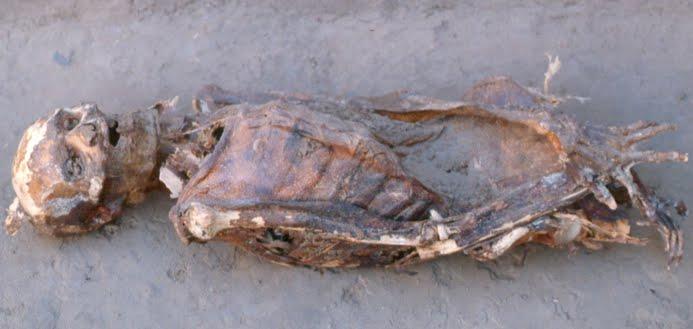Parasitized throughout the ages
Nubian mummies chronicle a modern plague
Rachel Nuwer • July 13, 2011

Nubian mummies retained traces of ancient schistosomiasis infection [Image Credit: Dennis Van Gerven]
Along the muddy, slow-moving canals of the Nile River, people today know what may lurk in the water. Schistosomiasis, caused by blood-devouring worms reliant on snails for transmission, currently ranks after malaria as the second most socio-economically devastating parasitic disease in the world. And research reveals that this trend is far from a recent development: Schistosomiasis has plagued Nile populations for over a millennium, and in much the same way as it does today.
Nubian mummies excavated near the Egyptian-Sudanese border lent scientists their ancient tissues to reveal their story. Nubians — who enjoyed a century-long rule over Egypt around 760 BC — were generally thought of as one of the healthiest communities of their time, says George Armelagos, a bioarchaeologist at Emory University. They self-medicated with the antibiotic tetracycline, purposefully brewed in beer, and didn’t have to worry much about bacteria due to the hot, dry climate. Their parasitic load was a different story, though.
By analyzing traces of antigens, or foreign substances that trigger the body’s immune response, anthropologists compared the schistosomiasis infection load of two different populations of Nubians from about 1,500 years ago. One population relied upon the ebb and flow of the Nile’s natural flooding regime to grow their crops. The other population altered the environment by digging canals and creating artificial irrigation. As it turned out, the community that altered its environment had a 25 percent higher parasitic load than the community that used natural flooding, which only had a nine percent infection prevalence.
By engineering a system of irrigation, the parasite-loaded population flourished in an otherwise hostile environment — but also created a plentiful habitat for snails that are necessary for the schistosomiasis worms to complete their lifecycle. The more heavily parasitized Nubian population “may or may not have known that people who use irrigation agriculture show signs of schistosomiasis,” says anthropologist Amber Campbell Hibbs, the lead author of the study published in the American Journal of Physical Anthropology in April. “But if their options are eating or schistosomiasis, they’re going to go with eating.” This reflects the predicament many modern populations living along the Nile face, too.
Studies like Campbell Hibbs’ can show us how populations cope with disease in the absence of modern medicine or preventative techniques. Today, we can kill the snails that transmit schistosomiasis or we can treat it with medication, says Annalisa Alvrus, a biological anthropologist at Mesa Community College in Arizona. Earlier paleopathology studies usually relied upon examinations of individual mummies, she says, but analysis of the entire population is critical for painting an overarching picture of the society that’s relevant for today. “We can examine infections of past populations and ask questions about how our modern interventions are working,” says Alvrus.
Examining an entire population can also reveal flaws in past assumptions. Two species of schistosomiasis parasites — S. haematobium and S. mansoni — commonly infect people in Africa today. S. haematobium is typically associated with unpolluted, oxygen-rich waters, whereas S. mansoni thrives in dirty, oxygen-poor waters linked to urbanization and development. An idea prevails amongst researchers that it was not until the advent of steam and gasoline powered engines introduced by Europeans that the shift from nature-loving S. haematobium to pollution-dwelling S. mansoni occurred. Surprisingly, though, Campbell Hibbs found S. mansoni to be the dominant parasitic culprit in her mummies. “There’s kind of this idea that S. mansoni became prevalent when Europeans showed up with Europeans technology that could really alter the environment,” Campbell Hibbs says. Her work draws attention to the fact that Africans were very much able to alter their environment prior to European encroachment, to the point that it had a significant impact on their health.
The legacy of the Nubians’ environmental impacts continues today. In Africa, communities accept that it’s almost impossible to completely get rid of schistosomiasis. The constant interaction with water in daily life guarantees re-exposure, so the goal is to limit the number of worms in a person’s blood stream. This strategy helps avoid some of the “really gnarly” symptoms of heavy infection, Campbell Hibbs says, like enlargement of the liver and spleen when the organs become bloated and clogged with excessive parasitic egg overloads. “This is something you can live with,” says Armelagos of the lighter infection load. “It does have consequences, but it isn’t always life-threatening.”
Any work highlighting the impact human behaviors have on the environment is critical today, says Alvrus. Like the Nubians so many years ago, she says, we’re still altering our environment and “at some point we’re going to have to pay the price for that, whether with schistosomiasis or something else.”